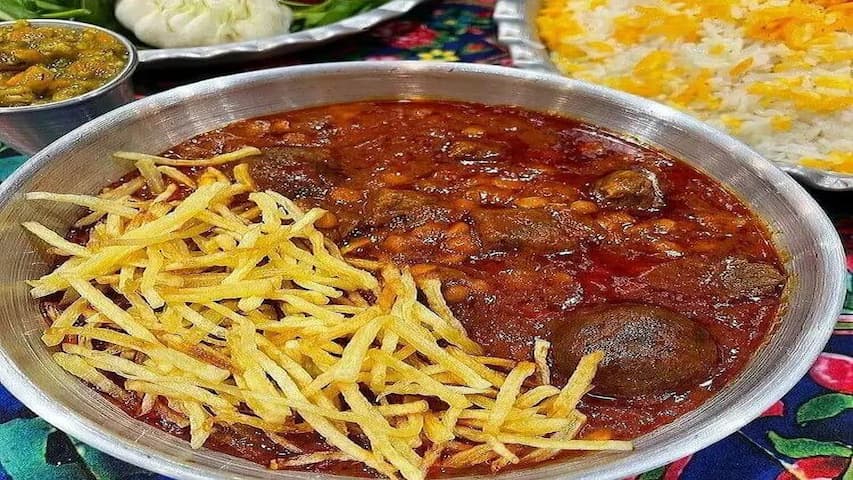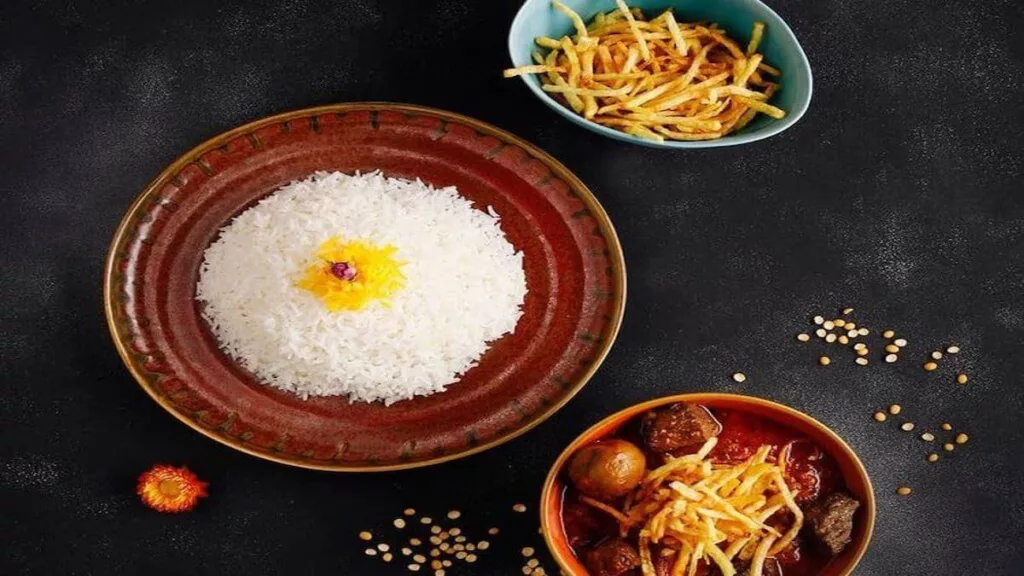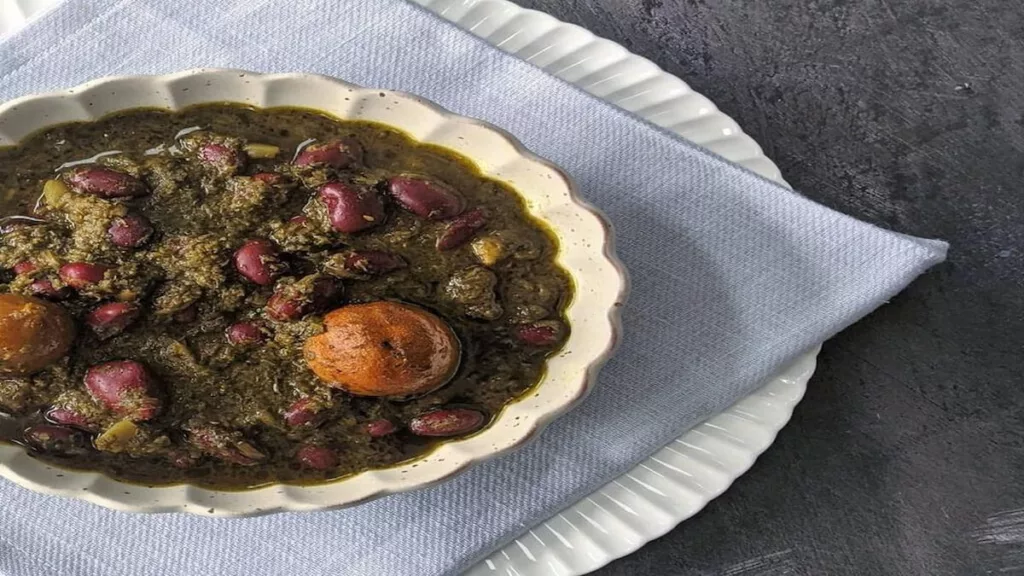Persian Gheimeh stew is a hearty and tasty dish that is a Persian cuisine classic. It’s a beef stew with yellow split peas and dried limes that’s usually served with steamed white rice. khoresht Gheymeh recipe is an excellent comfort food that is also healthful.
Table of Contents
What Is Gheymeh?
khoresht Gheymeh is not only a traditional Iranian meal, but it has also acquired international acclaim for its distinct flavor and scent. This stew is well-known for its substantial and rich flavor, making it an ideal comfort dish on chilly winter days. The cooking period for this stew is lengthy, but the end product is well worth the effort.
Gheimeh stew can be made in a variety of ways, and each location has its unique version. For example, in the northern portion of Iran, pomegranate paste is used to give the stew a tangy flavor, whilst in the southern region, coconut milk is used to give the stew a creamy texture.
The potato stuffing stew is one of the most well-known forms of this stew called gheimeh sibzamini. This stew has a particular flavor due to the use of cubed potatoes, meat, and a variety of spices. A common variation is eggplant stuffing stew called Gheymeh Bademjan, which is created by filling eggplants with meat and spices and then boiling them in a tomato-based sauce.
Read More: Zereshk Polo Ba Morgh Recipe (Persian Barberry Rice With Chicken)
This Iranian stew is made by first cooking the beef until it is soft, then adding the veggies, herbs, and spices. The stew is then cooked for several hours until the flavors combine harmoniously, yielding a wonderful and fragrant meal.
While making Qeymeh stew, it is essential to utilize high-quality ingredients and to take your time with the cooking process. The ultimate product will be a delicious and filling dish that is ideal for sharing with family and friends.
History Of Persian Gheymeh Stew
Gheymeh stew is a traditional Persian meal that has been enjoyed for ages in Iran and throughout the Middle East. The meal is thought to have originated in northern Iran, where it was prepared with lamb or goat meat and a variety of vegetables. Yellow split peas, which are now a significant element in this stew, were introduced to the recipe over time.
Read More : Easy Kuku Sabzi Recipe (Persian Herb Frittata)

Persian Khoresh Gheymeh Recipe
Cooking Persian Gheimeh stew is simple, but it does need time and patience. The key to producing a good Gheimeh stew is to let it boil for several hours to allow the flavors to mingle and the meat to tenderize.
Gheymeh ingredients
1 pound stew beef, chopped into tiny cubes
3 minced garlic cloves
1 chopped onion
a quarter cup of oil
1 tablespoon turmeric
1 teaspoon cumin powder
a half teaspoon cinnamon
1/2 teaspoon black pepper, ground
1/2 teaspoon black pepper, ground
1/2 cup soaking yellow split peas 3 dried limes pierced with a fork
4 cups water
Season with salt to taste.
1/2 cup fresh parsley, chopped
1/2 cup fresh cilantro, chopped
How to Make Persian Gheimeh Step By Step
- In a big pot, heat the oil over medium heat. Sauté the chopped onion until transparent, about 5-7 minutes.
- Sauté the minced garlic for another 1-2 minutes, or until fragrant.
- Sauté the minced garlic for another 1-2 minutes, or until fragrant.
- Cook until the beef stew meat is browned on all sides, about 5-7 minutes.
- Stir in the turmeric, cumin, cinnamon, and black pepper to coat the meat with the spices.
- To the pot, add the soaked yellow split peas, dried limes, and water. Bring to a boil, then lower to a low heat and cover with a lid.
- Cook, stirring periodically, for 1- hours, or until the meat and split peas are soft and the stew has thickened.
- Remove and discard the dried limes (limoo amani) from the stew.
- Season the stew with salt and pepper to taste.
- Stir in the fresh parsley and cilantro until completely combined.
- With steaming white rice, serve the stew hot.
To begin making this stew, sauté chopped onions and minced garlic in oil until transparent and aromatic. Brown the beef stew meat on both sides in the saucepan. Then, whisk in the spices, including turmeric, cumin, cinnamon, and black pepper, to coat the meat.
Then, pour in the soaked yellow split peas, dried limes, and water. Bring the stew to a boil, then lower to a low heat and cover with a lid. Cook, stirring periodically, for 1-2 hours, or until the meat and split peas are cooked and the stew has thickened.
Read More: Ghormeh Sabzi Recipe | Easy Persian Herb Stew
Remove the dried limes from the saucepan and discard them after the stew has finished boiling. Season the stew with salt and pepper to taste, then garnish with fresh parsley and cilantro. With steaming white rice, serve the Gheimeh stew hot.

Gheymeh Calories
The calorie content of a normal serving of Qeymeh varies based on the recipe and serving size, however below is an approximate breakdown of the calorie content of a typical portion of this stew cooked with beef or lamb:
- Gheymeh prepared with beef or lamb, 1 cup: 350-400 calories on average
- 1 serving (1 cup) Basmati rice: Between 200 and 250 calories
- One tablespoon of frying oil has around 120 calories.
A standard dish of Gheymeh with beef or lamb, rice, and fried potatoes may have 670-770 calories. Please keep in mind that these are only estimations, and the calorie content will vary based on the precise components and cooking techniques utilized.
Read More : Fesenjan Recipe (Persian Pomegranate walnut Chicken Stew)
Is Gheymeh Healthy?
When made with good ingredients and in moderation, this stew may be a healthy and nutritious dish. These are some things to think about:
- Persian Gheymeh’s main component, yellow split peas, is abundant in fiber, protein, and vitamins and minerals including folate, iron, and potassium. These nutrients can aid with digestion, inflammation reduction, and heart health.
- Gheimeh is also commonly made with tomatoes, onions, garlic, and other vegetables and spices, which can give extra vitamins, minerals, and antioxidants.
- Certain forms of this stew, on the other hand, may have additional sugar, harmful fats, and excessive levels of salt, which might detract from its overall nutritious quality.
- Gheymeh is frequently served with rice and fried potatoes, which can add calories and carbs to the meal.
Nevertheless, when made with lean protein and nourishing ingredients and eaten in moderation with a variety of vegetables and good grains, this stew may be a healthy and balanced dinner. Like with any cuisine, portion proportions should be considered, and this stew should be balanced with other nutrient-rich foods as part of a well-rounded diet.
FAQ
What is the nutritional value of Khoresh Gheimeh?
When prepared with nourishing ingredients and eaten in moderation, this stew may be a nutritious dish. The major component in the stew, yellow split peas, is abundant in fiber, protein, vitamins, and minerals. Nevertheless, depending on the ingredients and cooking methods employed, the meal can be rich in calories and salt.
How long does it take to prepare Khoresh Gheymeh?
The cooking time for Khoresh Gheymeh varies based on the recipe and method used. The stew is typically cooked for at least an hour, or until the split peas are soft and the sauce has thickened.
Can I make Khoresh Gheymeh without meat?
Yes, you may make a vegetarian version of this stew by omitting the meat and substituting vegetable broth or water for the beef or lamb stock.
How should khoresht Gheymeh be served?
Traditionally, this Khoresh is eaten with Basmati rice (Polo) and fried potatoes. Some people like to top the meal with fresh herbs, such as parsley or cilantro.
Is it possible to make gheimeh using chicken?
This khoresht (Stew) can be made using chicken. In reality, this stew (khoresht) may be cooked with a variety of meats, including beef, lamb, and chicken. To create chicken gheymeh, just replace the meat in the recipe with chicken and modify the cooking time appropriately, as chicken cooks faster than beef or lamb. You may make this recipe with boneless, skinless chicken thighs or breasts.
Have you ever tried making this delectable stew? If you run across any issues when making this stew, please let us know. Likewise, if you would like another Persian stew recipe to be added on the site, please let us know.



